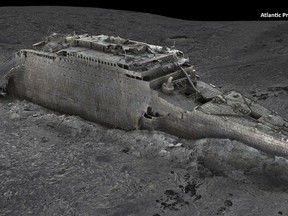The (incredibly expensive) Titanic tourism industry that just lost a submarine
When OceanGate Expeditions began operations in 2018, they boasted of having the world’s only privately-owned vehicles capable of reaching the Titanic

Article content
Only a few days after setting out from St. John’s, N.L., a tourist expedition to the wreck of the RMS Titanic has gone missing.
Both the U.S. Coast Guard and Canada’s Joint Rescue Coordination Centre in Halifax confirmed that a deep-sea submersible was reported overdue on Sunday night. An RCAF Aurora patrol aircraft and the Canadian Coast Guard vessel Kopit Hopson were soon underway to assist in search and rescue operations.
There was no sign of the submersible as of press time, but the incident may already have done inalterable damage to what has previously been one of the world’s most exclusive tourist experiences.
Climbing Mount Everest costs about $50,000. A ticket to space could soon cost only $100,000. But descending to the RMS Titanic currently costs US$250,000 ($330,000) per person.
The missing submersible is owned by OceanGate Expeditions, a U.S.-based company whose vessel, the Polar Prince, is partially owned by the Newfoundland and Labrador-based Miawpukek First Nation. “This is your chance to step outside of everyday life and discover something truly extraordinary,” reads a description for the company’s June 2023 Titanic expedition.
On Monday, it emerged that one of the missing submersible’s passengers is U.K. billionaire Hamish Harding.
Although media reports said the search was being conducted “off the coast of Canada,” that’s only technically true: The search area is a remote patch of the North Atlantic more than 600 kilometres from Newfoundland.
The isolation of the area is one of the reasons that the Titanic disaster was so deadly; although many vessels heard the liner’s wireless calls for distress, none were close enough to get to the ship before it had foundered and most of its passengers had died of exposure.
The RMS Titanic is not only the world’s most famous shipwreck, but it’s one of the hardest to reach.
The vessel — which sank on its maiden voyage in April, 1912 — lies under nearly four kilometres of Atlantic Ocean. That’s 12 times deeper than history’s deepest scuba dive, and four times deeper than the lowest depth ever reached by a conventional U.S. Navy submarine. Merely descending to the wreck takes about two hours.
That’s one of the reasons the wreck wasn’t discovered until 1985.
It wasn’t until after the Second World War that marine technologists — most notably the French oceanographer Jacques Cousteau — were able to pioneer the development of submersibles that could reach the bottom of the mid-Atlantic without getting crushed.
To this day, there’s still only a handful of vehicles that can safely carry humans to the wreck, almost all of which are in the hands of militaries and research institutions.
The wreck was first explored in the 1980s with ALVIN, a research submersible owned by the Woods Hole Oceanographic Institution. And when Canadian filmmaker James Cameron dove to the site to shoot footage for his 1997 blockbuster Titanic, he hired Mir 1 and Mir 2; deep-sea submersibles operated by the Russian Academy of Sciences.
Ever since the 1990s, there has been a steady trickle of sightseeing expeditions to the Titanic wreck. The two Mir submersibles were contracted for a tourist expedition in 1998, and in 2001 an American couple even arranged to be married in a submersible perched on the bow of the sunken vessel; they’d won the dive in a competition offered by the British company SubSea Explorer.
These have not been uncontroversial. The sinking claimed the lives of more than 1,500 people, only a few hundred of which had their bodies recovered, meaning that the wreck is officially a mass grave. RMS Titanic Inc. — the U.S. company that owns salvage rights to the wreck — has also sought court injunctions against earlier sightseeing visits.
When OceanGate Expeditions began operations in 2018, they boasted of having the world’s only privately-owned vehicles capable of reaching the Titanic.
The missing craft is the Titan submersible, which has room for four passengers and one crew member. Specs released by OceanGate note that it is lighter than most of its deep-sea submersible peers by virtue of being partially constructed from carbon fiber rather than the traditional titanium.
“In coastal waters this means we do not need a large support ship with a crane or A-frame,” they write.
Quick facts about the missing Titanic submersible, Titan, and owner OceanGate Expeditions
A search is underway in an area of the Atlantic Ocean about 700 kilometres south of Newfoundland for a small submersible reported missing during a dive to view the wreckage of the Titanic. Here are a few facts about the missing vessel and its owner, Washington-based OceanGate Expeditions.
1. The Titan is a 6.4-metre manned submersible made of carbon fibre and titanium, designed to carry five people to depths of up to 4,000 metres for “site survey and inspection, research and data collection, film and media production, and deepsea testing of hardware and software,” according to OceanGate’s website. The craft includes a large viewport to allow passengers to view their surroundings, and is lowered into the water with the help of what the company calls a “patented, integrated launch and recovery platform.”
2. The vessel carried a combination of crew and tourists, who pay huge fees to view the wreck site and participate in research tasks. The Canadian Press reported that in 2019, the price was about $168,000 per ticket — an amount said to subsidize the company’s Titanic research mission.
3. The company says its mission includes chronicling the deterioration of the wreck of the Titanic, which sank in 1912, leading to the deaths of more than 1,500 people. The expeditions capture photos and video to document the condition of the site, as well as the plants and animals in and around it. “What we’re doing is something that’s going to add to the historical record of the Titanic — what is it like now, how is it decaying, what kind of marine life is there,” CEO Stockton Rush told The Canadian Press in 2019.
4. A promotional video on the company’s YouTube channel says the passengers depart from St. John’s, N.L., aboard a surface vessel for an eight-day journey. The trips down to the Titanic wreck are monitored by specialists in a command centre aboard the ship, on which guests are treated to lectures and conversations with scientists, and help out with various tasks related to research.
5. The company says the submersible includes a real-time health monitoring system, which makes it possible to analyze the effects of changing pressure on the submersible as it dives. The submersible is said to have a life-support system lasting 96 hours.
6. Rush founded OceanGate in 2009. It carried out successful Titanic expeditions in 2021 and 2022, the website says.
Our website is the place for the latest breaking news, exclusive scoops, longreads and provocative commentary. Please bookmark nationalpost.com and sign up for our daily newsletter, Posted, here.













Postmedia is committed to maintaining a lively but civil forum for discussion. Please keep comments relevant and respectful. Comments may take up to an hour to appear on the site. You will receive an email if there is a reply to your comment, an update to a thread you follow or if a user you follow comments. Visit our Community Guidelines for more information.